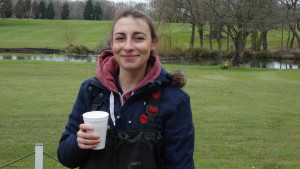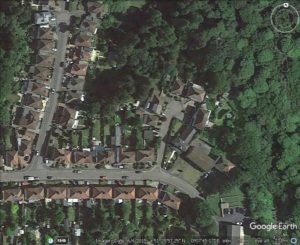Summary: As envisaged in the 2015 report, White Admiral was confirmed as a Bexley resident at two woodland locations during 2016, taking the Borough’s total of butterfly species to 29. Clouded Yellow was more numerous than usual with sightings of 12 individuals across 3 lower Cray catchment locations, Crossness and East Wickham Open Space. Marbled White was found at a new site, but there were no definitive signs that it was managing to establish a permanent foothold in Bexley this year. Brown Argus was seen at three new locations, Small Heath at two and Green Hairstreak at one. Small Tortoiseshell remained low in numbers and was mainly spotted at the usual relative hotspots out on the marshes. There were few Painted Lady reports and Small Copper was worryingly thin on the ground, reflecting what appears to be a national decline. On May 1st Joe Johnson launched the Bexley Butterfly and Moth Facebook page – https://www.facebook.com/BexleyButterflyandMothGroup/ – and at 15/12/16 this had 53 likes and 50 followers.
White Admiral (Limenitis camilla). Tantalising records from last year strongly suggested that this species occurred in Bexley, but observers had not been sure that they had seen it within the Borough’s boundary. It is very uncommon in London, with reports from only 3 sites to as recently as 2015.
Steve Carter saw a White Admiral in Joydens Wood on July 18th 2016 and reported it on the ‘Bexley Wildlife’ Facebook page. When quizzed he gave an approximate grid reference which appeared to put him on the main path heading south-east from the Keeper’s Cottage, and was within Bexley. Armed with this information, Bexley Butterfly and Moth Group’s Joe Johnson, Mike Robinson and Chris Rose went in search of further sightings in this area on July 23rd. In the meantime, Mike had photographed one at the Parsonage Lane end of the wood on July 21st, believing that this too was inside the Bexley boundary.
The weather was somewhat changeable, with periods of no sun, then butterflies taking to the air as soon as it came out again. But we were in luck, seeing a White Admiral in the first area of young coppice by the side of the aforementioned path that we came to, well within the Bexley boundary.
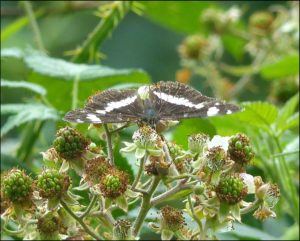
White Admiral, Joydens Wood, 21st July 2016. (Photo: Mike Robinson)
During the late afternoon of the 23rd, Chris Rose (now solo) saw another along the ride that continues beyond the end of Parsonage Lane, which is pretty much on the Bexley/Kent border. He then found two more White Admirals in clearings in Gatton’s Plantation, which is wholly within Bexley. These latter sightings indicate that the 2003 record of the species made at the Plantation by top botanist Mark Spencer, but which the London biodiversity records centre (GiGL) has classed as ‘unverified’ was probably, in fact, correct.
Silver-washed Fritillary (Argynnis paphia). This species has only been recorded from a handful of sites in London, and was confirmed as resident in Bexley in 2015. On July 23rd 2016 Joe Johnson, Mike Robinson and Chris Rose visited Joydens Wood and saw a few of these insects in coppiced areas along the main path heading south-east from the Keeper’s Cottage, within the Bexley boundary. Chris Rose also saw one later that day along the ride that continues beyond the end of Parsonage Lane, which is essentially on the Bexley/Kent border.
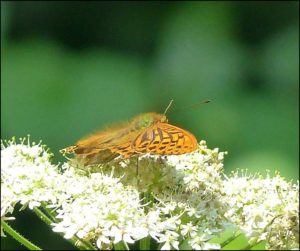
Silver-washed Fritillary on Hogweed in the Bexley part of Joydens Wood, 23rd July 2016. (Photo: Mike Robinson)
Mike also discovered the species in Gatton’s Plantation, which is next to Joydens Wood, and wholly within Bexley, on August 16th.

A rather worn Silver-washed Fritillary pictured at Gatton’s Plantation 16th August 2016. (Photo: Mike Robinson)
Clouded Yellow (Colias crocea). This migrant species is only very occasionally seen in Bexley, so twelve in one year is somewhat exceptional. As usual, sightings were predominantly from our ‘coastal’ areas. Purnendu Roy saw and photographed one at East Wickham Open Space on August 11th. Mike Robinson saw one at Crossness on August 17th and two there on the 24th. Steve Carter then reported seeing six at Crayford Marshes on August 26th. Chris Rose found one on the derelict former Electrobase industrial site in Crayford town centre, next to Roman Way, on September 11th and saw another on September 14th Sept at the south end of By-way105 by the River Cray near Maiden Lane. What was at the time thought to have been a distant Jersey Tiger at Thames Road Wetland, may in retrospect have also been a Clouded Yellow, given the understanding of apparent colour and flight characteristics developed out of later sightings.

Clouded Yellow at East Wickham Open Space, 11th August 2016 (Photo: Purnendu Roy)
Marbled White (Melanargia galathea). With two sightings in Bexley in 2015, records from both Bromley and Greenwich between 2012 and 2015, Ladywell Cemetery in Lewisham in 2015 and LNHS 2014 butterfly count data for London giving the highest Marbled White figures since reliable information for the species first became available in 1997, there were hopes that the species might be on the verge of ‘doing a Ringlet’ and begin to spread quickly across the Borough. There was only one confirmed record, however, with Mike Robinson getting a photo of a single specimen at Upper College Farm, a new site record, on 17th July 2016. Shaun Marriott, Site Manager at London Wildlife Trust’s Braeburn Park reserve in Crayford said in July that he had been told that the species had been seen there, but we have not been able to verify this to date.

Marbled White at Upper College Farm, July 17th 2016. (Photo: Mike Robinson)
Ringlet (Aphantopus hyperantus). The rise of the Ringlet in Bexley appears to have begun around 2011/2012. It has since colonised the many suitable sites that have been studied. The only noteworthy new record was of 32 individuals seen flying in a small part of Braeburn Park on July 10th by Chris Rose.
Small Heath (Coenonympha pamphilus). This small, pale butterfly is a Biodiversity Action Plan species for research due to an apparent decline, including due to loss of habitat. Mike Robinson confirmed and photographed it at Upper College Farm on May 26th, when it transpired that Ian Stewart had first seen it there about 3 years ago but had not submitted the record to GiGL.
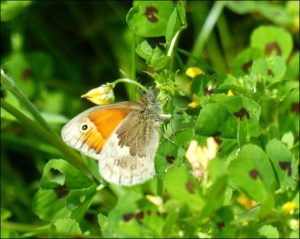
Small Heath at Upper College Farm on 26th May 2016. (Photo: Mike Robinson)
Chris Rose saw and netted a single specimen on a dry grassy bank at Thames Road Wetland on June 6th, and was able to make doubly sure of the ID before release. He also saw a few flying a Braeburn Park on July 10th. These were both new site records. The species has previously been recorded over on Crayford Marshes, so the Wetland insect may well have been a lone wanderer or wind-blown individual. According to GiGL data it has also been seen over the railway line from Braeburn at Crayford Rough, but not since 2007. Mike Robinson actively looked for the species at East Wickham Open Space on June 6th, but couldn’t find any.
Small Tortoiseshell (Aglais urticae). Numbers of this once frequent species remain severely depressed, with records continuing to come mainly from locations nearer to the Thames. Mike Robinson has submitted the most sightings. He saw his first for the year on 28th January in the gardens at Hall Place. The most he saw on any one day during 2016 was seven on 19th April at Crossness (this compares to his highest figure for 2015 of thirteen on 3rd July, again at Crossness). Others were beside a Public Footpath off Church Manorway, beside the Thames Path in both the Belvedere and Erith areas, at Crayford Marshes, Crayford Rough, East Wickham Open Space, the Hall Place flood overspill area, Hollyhill Open Space, Lesnes Abbey park/Woods and beside the Upper Bedon Stream (Streamway). He has commented that he probably saw around half the number of individuals he witnessed in 2015. Steve Carter saw one at Crossness 17th August and two on Crayford Marshes on 26th August. Amongst others, Chris Rose saw one each on 10th July and 16th August at Braeburn Park.
Painted Lady (Vanessa cardui). Another poor year for this migrant from Africa. On 5th June Chris Rose saw one in a garden part way down Midhurst Hill, Bexleyheath, feeding on Red Valerian, and a second on Bramble flowers at Parish Wood Park. Also on 5th June Mike Robinson saw two at Lesnes Abbey park/Woods, plus one in the East Wickham Open Space on 6th June, one on 26th June beside a public footpath off Church Manorway and one on Crayford Marshes on the same day. In general terms Mike reckoned he probably saw less than half as many as he had done in 2015. Other records included Thames Road Wetland on 29th July (Chris Rose), 10th August and 12th September at Crossness Nature Reserve (Steve Carter), 14th August at Lesnes Abbey (Mike Robinson), 16th August at Braeburn Park and a pristine individual on 29th August at Grasmere Road allotment site (Chris Rose), and Crayford Marshes on 26th August (Steve Carter) – all of which were singletons.

Painted Lady at Lesnes Abbey, 14th August 2016. (Photo: Mike Robinson)
Green Hairstreak (Callophrys rubi).
Two sightings of the species by Chris Rose at Thames Road Wetland on the 20th and 21st of May constituted a new site record, some distance from other known locations in the Borough.

Green Hairstreak, Erith Southern Marsh. May 13th 2016. (Photo: Mike Robinson)
Small Copper (Lycaena phlaeas). Very few reported sightings, all singles. These were 4th June at Hollyhill (Mike Robinson), Braeburn Park on 10th July (Peter Beckenham), one beside the Upper Bedon Stream (Streamway) on 14th July (Mike Robinson), in a glade at Martens Grove on 11th September and another at Grasmere Road allotment site on 13th September (Chris Rose). Finally, one was seen and photographed by Mike Robinson at the closed Thamesview Golf Course on 15th September, who has commented that this species was “Massively down on 2015”.

Small Copper, Thamesview Golf Course. 15th September 2016. (Photo: Mike Robinson)
Brown Argus (Aricia agestis). There were new site records from the small area of land between Gascoyne Drive and Thames Road (adjacent to Perry Street Farm) where there was perhaps only one individual, at Grasmere Road Allotment site and at Thames Road Wetland, all discovered by Chris Rose.
This report has been sent to the London Natural History Society butterfly recorder for its 2017 journal, which will contain the 2016 transect count and species status reports and be published in early 2018.
Report compiled by Chris Rose.
